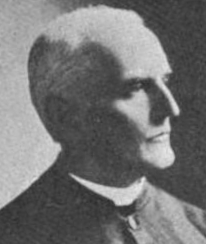يوهان گيورگ هاگن Johann Georg Hagen
Johann Georg Hagen | |
|---|---|
 Hagen in a 1917 publication | |
| وُلِدَ | مارس 6, 1847 Bregenz, Austria |
| توفي | سبتمبر 6, 1930 (aged 83) Rome, Italy |
| التعليم | |
| المهنة | Clergyman, astronomer |
يوهان گيورگ هاگن (6 مارس 1847 - 6 سبتمبر 1930)، قس يسوعي وفلكي نمساوي، أصدر زيجاً بالنجوم المتغيرة (1890--1908). أثناء عمله في مرصد الڤاتيكان أعاد الفحص، من أجل الدقة، قائمة كل أجرام NGC (الزيج العام الجديد للسدم والأعقاد) الواقعة شمال تقريباً -30 درجة. وقد نشر قوائم تصحيح في الـNGC. وأثناء أرصاده، لاحظ سدم داكنة، مجموعات داكنة من المواد النجمية تعرف أحياناً باسم سحب هاگن. لم يتم تسجيل هذه السحب الغريبة من قبل الآخرين، وتُعزى الآن إلى أوهام بصرية مرتبطة بالملاحظات البصرية. وقد كان الجزويت منخرطين في الفلك منذ 1551 حين ساعد الراهب كريستوف كلاڤيوس، عالم الرياضيات والفلكي، البابا گريگوري الثالث عشر في اصلاح التقويم.
After serving as Director of the Georgetown University Observatory he was called to Rome by Pope Pius X in 1906 to be the first Jesuit director of the new Vatican Observatory. Father Hagen was also the spiritual director of Maria Elizabeth Hesselblad (1870-1957), who was baptized by him on August 15, 1902 and eventually was canonized on June 5, 2016 by Pope Francis.[1]
Early life
Johann Georg Hagen was born in Bregenz, Austria on 6 March 1847, the son of a school teacher.[2]
Entering the Jesuit Order
Johann entered the Society of Jesus, commonly known as the Jesuits, in Gorheim, Germany in 1863. He attended the Jesuit College Stella Matutina in Feldkirch, Austria and also studied mathematics and astronomy at the University of Bonn and the University of Münster. He volunteered for the ambulance service in the Franco-Prussian War, but was struck with typhoid fever.
Expulsion
On July 4, 1872, Otto von Bismarck, chancellor of Germany, expelled the Jesuits from the German Empire. Johann left for England where he was eventually ordained into the priesthood.
Emigration to US
In June 1880, he left England for the United States. There he began teaching at Sacred Heart College in Prairie du Chien, Wisconsin. There he cultivated his interest in astronomy and built a small observatory for making astronomical observations. In Wisconsin, he became a naturalized citizen.
He was called to serve as the Director of the Georgetown University Observatory in 1888. There he continued his research and published numerous articles and texts. In mathematics, the Rothe–Hagen identity is named after him; it appears in his three-volume 1891 publication, Synopsis of Higher Mathematics.
He contributed several articles on astronomical topics to the Catholic Encyclopedia.[2]
Vatican Observatory
In 1906, John was called by Pope Pius X to take charge of the Vatican Observatory in Rome. He died in Rome on September 6, 1930.[3]
The crater Hagen, 55 km in diameter, on the far side of the Moon is named after him.
Publications
- Atlas Stellarum Variabilium (Atlas of variable stars) (in Latin). Berlin: Felix L. Dames. 1890–1908.
{{cite book}}: CS1 maint: unrecognized language (link)[4] - with G. A. Fargis: The photochronograph, and its applications to star transits. Georgetown, D. C.: Georgetown College Observatory. 1891.[5]
- Synopsis der höheren Mathematik. Vol. 4 vols. Berlin: F. L. Dames.Vol. 1: Arithmetische und algebraische Analyse. 1891.Vol. 2: Geometrie der algebraischen Gebilde. 1894.Vol. 3: Differential- und Integralrechnung. 1905.Vol. 4: Differentialgeometrie der Ebene und des Raumes. 1930.
- Index operum Leonardi Euleri. Berlin: F. L. Dames. 1896.[6]
- Hagen, J. G. (1900). "On the history of the extensions of the calculus". Bull. Amer. Math. Soc. 6 (9): 381–390. doi:10.1090/s0002-9904-1900-00733-6. MR 1557730.
- La rotation de la terre, ses preuves mécaniques anciennes et nouvelles. Rome: Tipografia Vaticana. 1911.
See also
References
- Wisconsin Journal of History, December 1941, page 180.
- Stein, J. (1931), "Johann Georg Hagen, S. J.", Popular Astronomy 39: 8, Bibcode: 1931PA.....39....8S
- ^ "Maria Elisabetta Hesselblad (1870–1957)". Vatican News. Retrieved 2021-06-09.
- ^ أ ب The Catholic Encyclopedia and its Makers. The Encyclopedia Press. 1917. p. 72. Retrieved 2021-06-09 – via archive.org.
- ^ "Father Hagen Dies, Vatican Astronomer". Courier-Post. Vatican City. INS. 1930-09-06. p. 2. Retrieved 2021-06-09 – via Newspapers.com.
- ^ Parkhurst, J. A. (1907). "Review: Atlas Stellarum Variabilium, by Johann G. Hagen". Astrophysical Journal. 25: 361–362. Bibcode:1907ApJ....25..361.. doi:10.1086/141461.
- ^ Jacoby, Harold (1891). "Review: The photochronograph, and its applications to star transits, by J. G. Hagen and G. A. Fargis". Bull. Amer. Math. Soc. 1 (2): 44–46. doi:10.1090/s0002-9904-1891-00025-5.
- ^ Ziwet, Alexander (1897). "Review: Index operum Leonardi Euleri, by J. G. Hagen". Bull. Amer. Math. Soc. 3 (7): 256. doi:10.1090/s0002-9904-1897-00417-7.
- Short description is different from Wikidata
- 1847 births
- 1930 deaths
- People from Bregenz
- 19th-century Austrian Jesuits
- 20th-century Austrian astronomers
- Emigrants from Austria-Hungary to the United States
- University of Bonn alumni
- Georgetown University faculty
- Catholic clergy scientists
- 19th-century American Jesuits
- 20th-century American Jesuits
- Jesuit scientists
- Contributors to the Catholic Encyclopedia
- 19th-century Austrian astronomers

